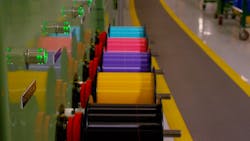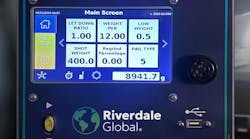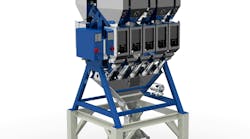By Bruce Geiselman
Materials science company Corning Inc. is exploring the possibilities of 5G wireless, using it to run cutting-edge technologies to create the fiber optic cable that’s required to bring greater processing power to homes and businesses.
At its facility in Hickory, N.C. — one of the largest fiber optic cable manufacturing facilities in the world— Corning has experimented with machine learning, artificial intelligence, augmented reality, virtual reality and autonomous mobile robots (AMRs), using Verizon’s 5G Ultra Wideband.
Corning is using Verizon’s 5G Edge service, which consists of a private 5G network using millimeter-wave spectrum with AWS Outposts (a multi-access edge computing platform from Amazon Web Services). Corning and Verizon worked together to create an architecture that protects sensitive information while combining on-premises and cloud-based services, covering data collection and storage, machine learning models and analytics, and network monitoring..
“What’s kind of unique is we’re experimenting with this technology that’s enabled by what we make at that factory,” said Mike Bell, senior VP and GM of Corning Optical Communications LLC.
According to Verizon’s website, “Verizon 5G Ultra Wideband offers speeds to users up to 10 [times] faster than typical 4G LTE speeds.”
To support applications that need real-time communications, such as AMRs and real-time quality control inspections, Hickory’s network boasts massive bandwidth and low latency (a minimal delay in the processing of computer data over a network connection).
“We’ve enabled 5G inside the factory, and we’ve brought in mobile edge computing (MEC),” Bell said. “We’re doing it in a test mode. We have a lot of ideas. … We’re testing some of those ideas out in real life with a real 5G network.”
Corning, which is focused on three core technologies — glass science, ceramic science and optical physics — aims to be the lowest cost and best manufacturer of fiber optic cable in the United States, and to do that, “it can’t be super labor-intensive,” Bell said. “It has to be appropriately labor-intensive.”
One example of automation enabled by 5G technology involves quality control on a plastics extrusion line that produces fiber optic cable. Extruded plastic encases the fiber optics to protect them against the forces they’ll experience in outdoor installations. Like any other manufacturer, Corning wants to ensure that its products are perfect and meet specifications, Bell said.
“In this case, we’re looking at visual flaws,” he said. “We run an extrusion process, and it’s possible that we could create a flaw. So, we have cameras and vision systems to look at the product as it’s coming out. … We take pictures of virtually every millimeter of this thing, even though it may be several kilometers long. We’re looking for anything that looks abnormal.”
In the past, anything that appeared abnormal would be flagged and people would need to intervene to determine if a flaw existed, identify the flaw, and figure out what caused it and how to correct it. However, Corning now is using artificial intelligence and deep learning to automate the process; it still relies on employees to determine corrective actions.
“We created a lot of training images, something like 15,000 of them, and then we put it into a machine learning algorithm,” Bell said. “We needed 5G to connect that simple image-producing device to this mobile edge computing capability, recognize what the thing is in real time, and then categorize it. That basically takes an engineer or humans out of the process.”
Accuracy is equally important to avoid rejecting good products and to avoid allowing a product with a real problem from getting out into the field, Bell said.
“What I would say is, it’s better than the humans,” Bell said. “Now, the machines are 97 percent capable of recognizing and categorizing without error those images.”
Making the optical fiber the plastic sheathing protects is a “very fast” manufacturing process, Bell said. Considering demand for it, it has to be — Verizon alone has deployed more than 1 million route miles of fiber, said Sampath Sowmyanarayan, CRO for Verizon Business, who spoke In November during the Manufacturing & Technology Show in Cleveland sponsored by Endeavor Business Media.
“I think that takes you around the world 40 times,” Sowmyanarayan said.
The proprietary vision system for inspecting the optical fiber — the hair-thin strands of glass inside the optical cable, which carry data in the form of light signals — also depends on 5G.
The optic fiber is drawn at high speeds and has to be carefully monitored. This typically involves the collection of hundreds of thousands of data points per draw, and hours of engineering time in analysis afterward. Real-time data collection, transmission and inferencing deliver significant time savings in engineering productivity.
“We’re making things that are long and consistent,” Bell said. “We’re looking at the size of those things and looking for abnormalities there, as well, as you can imagine. We’re making millions of miles of stuff that Verizon is putting in the ground. We want to make sure there are no problems with all that stuff, but as we increase the speed of our process, we have a problem with data rates. How fast can you sample a thing?
“Then, since we’re sampling all that data, what do we do with the data? How do we characterize it? How do we discern not only whether the process is running well, which it usually is, but is the process shifting? Is the distribution a little wider or narrower? Why is that?”
Once a problem is spotted, the cause needs to be identified.
“That’s where this big data, mobile edge computing and 5G combination, we think, can do a lot of good,” Bell said.
Closing the loop
The ultimate goal is for machine learning technology to not only identify problems but figure out how to correct them.
Employing a closed-loop process control system would allow data from a vision inspection system to flow to PLCs on the production floor to correct manufacturing flaws. For example, if a manufacturer were producing a product on an extruder and a vision inspection system detected the product’s diameter was a little too big, it could either speed up the production line or slow the extruder to bring the product back into specification, Bell said. However, to be effective, communication must take place in real time, meaning low latency is extremely important.
“The brass ring for me is closed-loop process control,” Bell said. It is something that Corning is still working toward. A company spokesman described it as part of the technology’s longer-term potential.
Meeting the challenge
While manufacturers might see many benefits from 5G technology, they might also encounter some challenges, Bell said.
“Since it is a wireless technology, make sure that the right coverage and capacity is available for the particular location you are doing,” he said.
The fastest 5G technology, 5G mmWave, has limited range and the signal is susceptible to physical obstructions.
“Something as silly as a little thing blocking the sensor can be a problem to start with,” Bell said.
Manufacturers also need to address data security when transmitting sensitive or proprietary data. Corning worked with Verizon and Amazon on issues including who owns the data transmitted to Amazon’s servers and how Corning could be sure the data was secure.
Another challenge is that there aren’t yet a lot of 5G-enabled devices available for factory settings.
While wiring high-speed internet access to equipment throughout a plant is an alternative to 5G technology, there are places where wires won’t work, Bell said. In addition, it can be expensive to wire everything in a large manufacturing facility.
“We’re trying to use at Corning a more wireless-first approach to everything because it is just so much more adaptable,” Bell said.
Corning has only begun to scratch the surface of how 5G technology, MEC and automation might benefit manufacturers in the future.
“If you’re in manufacturing, let your mind go wild,” Bell said. “It’s amazing what this capability can bring in the future.”
Bruce Geiselman, senior staff reporter








